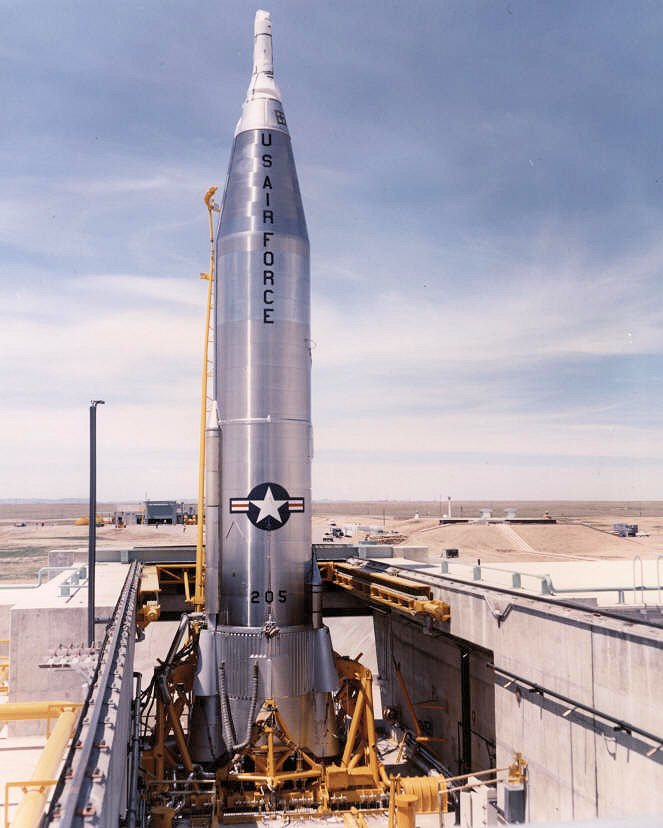
Atlas D
In-activeConvair ()
April 14, 1959
Description
The SM-65D Atlas, or Atlas D, was the first operational version of the U.S. Atlas missile. Atlas D was first used as an intercontinental ballistic missile (ICBM) to deliver a nuclear weapon payload on a suborbital trajectory. It was later developed as a launch vehicle to carry a payload to low Earth orbit on its own, and later to geosynchronous orbit, to the Moon, Venus, or Mars with the Agena or Centaur upper stage.
Specifications
-
Stages
1 -
Length
25.15 m -
Diameter
3.0 m -
Fairing Diameter
3.0 m -
Launch Mass
119.0 T -
Thrust
1880.0 kN
Family
-
Name
Atlas D -
Family
― -
Variant
D -
Alias
― -
Full Name
SM-65D Atlas
Payload Capacity
-
Launch Cost
― -
Low Earth Orbit
1400.0 kg -
Geostationary Transfer
Orbit
― -
Direct Geostationary
― -
Sun-Synchronous Capacity
―
Convair
Commercial
None
1943Convair, previously Consolidated Vultee, was an American aircraft manufacturing company that later expanded into rockets and spacecraft. The company was formed in 1943 by the merger of Consolidated Aircraft and Vultee Aircraft. In 1953 it was purchased by General Dynamics, and operated as their Convair Division for most of its corporate history.
Atlas D | OV1-11,12,86
Convair | United States of AmericaVandenberg SFB, CA, USA
July 27, 1967, 7 p.m.
Atlas D | OV1-9 & 10
Convair | United States of AmericaVandenberg SFB, CA, USA
Dec. 11, 1966, 9:09 p.m.
Atlas D | OV1-7
Convair | United States of AmericaVandenberg SFB, CA, USA
July 14, 1966, 2:10 a.m.
Atlas D | OV1-4 & 5
Convair | United States of AmericaVandenberg SFB, CA, USA
March 30, 1966, 9:20 a.m.
Atlas D | OV1-2
Convair | United States of AmericaVandenberg SFB, CA, USA
Oct. 5, 1965, 9:07 a.m.
Atlas D | OV1-3
Convair | United States of AmericaVandenberg SFB, CA, USA
May 28, 1965, 2:54 a.m.
Atlas D | FIRE 2
Convair | United States of AmericaCape Canaveral SFS, FL, USA
May 22, 1965, 9:55 p.m.
Status: Launch Successful
Mission:
FIRE (Flight Investigation of Re-Entry) was a high-speed reentry heat research program to obtain data on materials, heating rates, and radio signal attenuation on spacecraft reentering the atmosphere at speeds of about 24,500 miles per hour.
SuborbitalAtlas D | OV1-1
Convair | United States of AmericaVandenberg SFB, CA, USA
Jan. 21, 1965, 9:34 p.m.
Atlas D | FIRE 1
Convair | United States of AmericaCape Canaveral SFS, FL, USA
April 14, 1964, 9:42 p.m.
Status: Launch Successful
Mission:
FIRE (Flight Investigation of Re-Entry) was a high-speed reentry heat research program to obtain data on materials, heating rates, and radio signal attenuation on spacecraft reentering the atmosphere at speeds of about 24,500 miles per hour.
SuborbitalFalcon 9
Starlink Group 6-88
Space Launch Complex 40 - Cape Canaveral SFS, FL, USAA batch of 29 satellites for the Starlink mega-constellation - SpaceX's project for space-based Internet communication system.
Falcon 9
CSG-3
Space Launch Complex 4E - Vandenberg SFB, CA, USACSG-3 is an Earth observation satellite for the Italian Space Agency, part of a reconnaissance constellation using synthetic aperture radars operatin…
Long March 7A
Shijian 29 A-B
201 - Wenchang Space Launch Site, People's Republic of China2 satellites officially described as for "demonstration of new technologies for spatial targets detection" purposes.
Long March 4B
Tianhui 7
Launch Area 94 (SLS-2 / 603) - Jiuquan Satellite Launch Center, People's Republic of ChinaA satellite officially described as for cartography purposes, details TBD.
Soyuz 2.1b/Fregat-M
AIST-2T 01 & 02
Cosmodrome Site 1S - Vostochny Cosmodrome, Siberia, Russian FederationA pair of Russian optical Earth observation satellites built by the Progress Rocket Space Centre for obtaining stereo images of the Earth's surface, …

